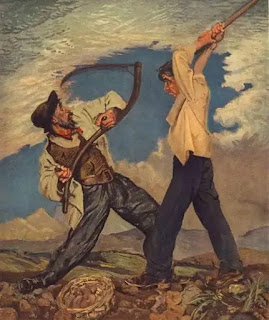The Playboy of the Western World as folk drama
The plays of John Millington Synge (1871-1909) are filled with the humour, sorrows, and dreams of the country folk of the Aran Islands and the western Irish coastlands. In The Playboy of the Western World, his most famous play, “we have a popular imagination that is fiery and magnificent, and tender.” In condemning the plays of Ibsen and Zola for “dealing with the reality of life in joyless and pallid works” and stressing his own desire for a stage that presented both ‘reality and ‘joy, Synge is pointing towards the source of his unique qualities as a dramatist. Rejecting the dominant mode of European drama of the early twentieth century with its concentration on what Thomas Kilroy has termed “the articulate life of the bourgeoisie”, Synge’s own brand of ‘realism’, through the depiction of Irish folk regain life, strove to re-instate a delight in life in all its aspects. Synge’s attitude towards his subject matter is clarified in a letter about Playboy to M.J. Nolan- the play shows, he says, that “the wildness and, if you will, vices of the Irish peasantry are due, as their extraordinary good points of all kinds, to the richness of their nature- a thing that is priceless beyond words.”
In answering critics who, far from seeing Playboy as in any way realistic sought to condemn the subject matter as being totally fantastic, Synge cited two well-documented cases of murderers who had been sheltered by the local population to prevent their arrest by the police. The idea for the play was undoubtedly sown by a story he heard on his travels in the Aran Islands, but the crucial difference introduced by Synge is the tone of the telling of the tale. In The Playboy, Synge uses his material to create a satirical comedy of peasant life, the ironic tone of which enables him to provide a tragic undertow to the whole piece which culminates in Pegeen’s grief-stricken outburst at the end of the play.
Within the setting’s isolation, there is a community. The tavern stands alone but is constantly filled with people. These people have carved an existence out of their remote setting, relying on contact with the larger world both through the post and the gossip at social gatherings. Nevertheless, this is a place beset by evil, both real and imagined. There are strange people out at night. from the madmen of Keel to the ten tinkers in the glen to the thousand militiamen in the countryside. Even the unseen priest, Father Reilly, haunts the action. The people surrounding this public house threaten it with madness, theft, war, or religion. Into this place comes Christy, a boy from eastern Ireland, and therefore one possessing more native wit than the westerners he encounters. He brings the evil of the outer world with him but wins over the local folk. When the truth is found out, they turn against him savagely.
Thus the tone of the play is the key to the mock-heroic parody. Christy is presented as a cowardly young layabout who yet grows in stature sufficient to be able to win the games but this very development is itself undercut by the reappearance of Old Mahon. Even when Christy apparently triumphs and leaves to lead a life of ‘romancing’ the audience, while treasuring his lively imagination, cannot fail to realize that his ‘heroism’ is hardly on a par with the heroes of the myths. In Synge’s picture of contemporary folklife, this is the level to which heroes are reduced; there is no room for a new Cuchulain. His approach to the presentation of Irish folklife on the stage demonstrates both his integrity as an artist and prefigures the preoccupations later seen in the work of dramatists like Samuel Beckett.

Very helpful content 😊